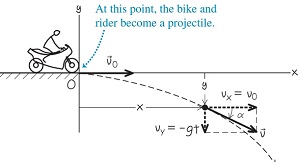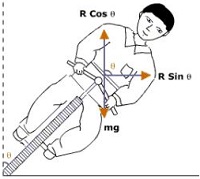Motion in A Plane - Online Test
We know that at the maximum height, the velocity of the ball is 0 m/s.
We also know that the ball takes the same time to reach its maximum height as it takes to travel from its maximum height to the initial position, due to time symmetry. The time taken is half the total time.
Therefore, we have the following information for the second (downward) part of the motion of the ball:
t = 5 second; half the total time
g = 9.8 m/s2 downward
s = ?
As we know
s = ut+
Put all the given value,
=> s =
=> s = 122.5 m
In order to take a safe turn, the cyclist has to bend a little from his vertical position. In this case, a component of the reaction provides the required centripetal force.
If q is angle made by the cyclist with the vertical then
Dividing (2) by (1), we get
=>
In actual practice, the value of q is slightly less because the force of friction also contributes towards the centripetal force.
The motorcycle’s x- and y-coordinates at t=0.50 s are

x = vox t= =4.5 m
y= = -1.2m
The negative value of y shows that the motorcycle is below its starting point.
The motorcycle’s distance from the origin at t=0.50 s is r= =4.7 m
A sports car has a “lateral acceleration” of 0.96g = 9.4 m . This is the maximum centripetal acceleration the car can sustain without skidding out of a curved path. If the car is traveling at a constant 40 m/s on level ground, what is the radius R of the tightest unbanked curve it can negotiate?
The car is in uniform circular motion because it’s moving at a constant speed along a curve that is a segment of a circle. Hence we know
R== =170 m
This is the minimum turning radius because arad is the maximum centripetal acceleration.
The speed is constant, so this is uniform circular motion. We are given the radius R=5.0 m and the period T=4.0 s, so we can calculate the acceleration directly using equation
== 12m/s2
Initial velocity u = 150 m/s
Angle
Vertical component is given by
= 75 m/s
At a distance L=400m from the traffic lights the brakes are applied to a locomotive moving at a velocity v=54km/hr. Determine the position of locomotive relative to the traffic lights 1 minute after the application of the brakes if its acceleration is -0.3m/s2.
Initial velocity u = 54 km/h = 15 m/s
Let Final velocity v = 0
Acceleration a = -0.3 m/s2
Time taken to stop = t
Using
=>
=> t = 50 sec
It means it has been stopped before 1 minutes.
So distance covered in 1 minute
=>
=> s = 375 m
Position of locomotive relative to the traffic lights= 400-375 = 25 m

